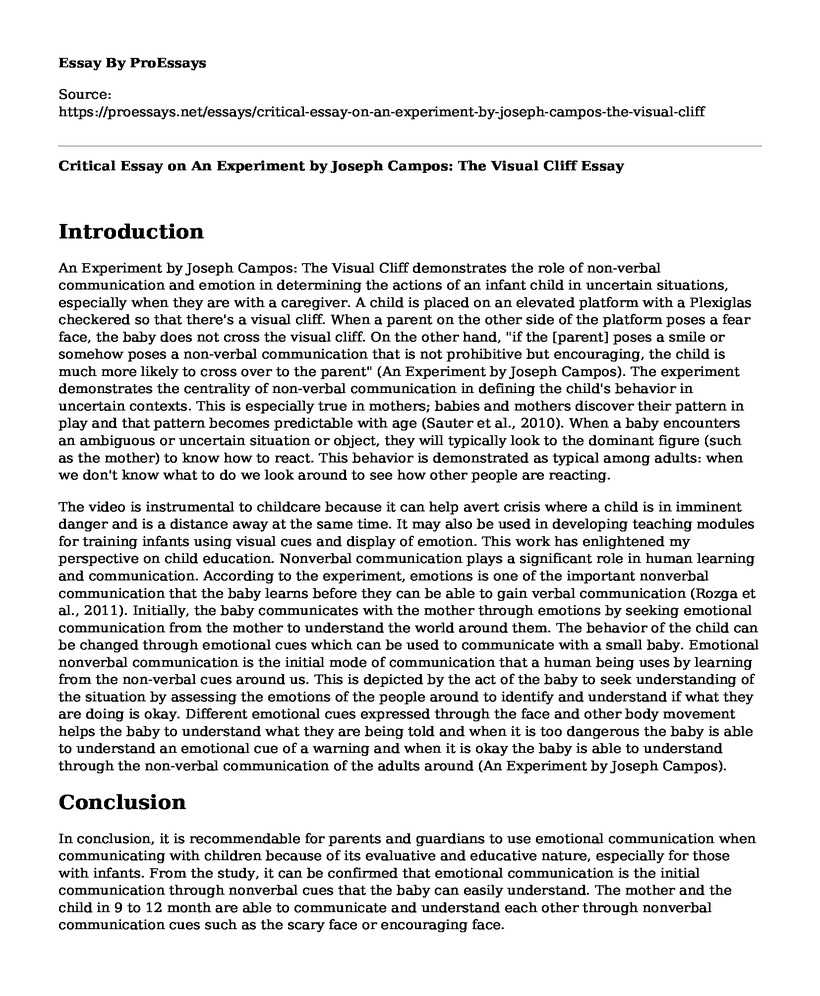Introduction
An Experiment by Joseph Campos: The Visual Cliff demonstrates the role of non-verbal communication and emotion in determining the actions of an infant child in uncertain situations, especially when they are with a caregiver. A child is placed on an elevated platform with a Plexiglas checkered so that there's a visual cliff. When a parent on the other side of the platform poses a fear face, the baby does not cross the visual cliff. On the other hand, "if the [parent] poses a smile or somehow poses a non-verbal communication that is not prohibitive but encouraging, the child is much more likely to cross over to the parent" (An Experiment by Joseph Campos). The experiment demonstrates the centrality of non-verbal communication in defining the child's behavior in uncertain contexts. This is especially true in mothers; babies and mothers discover their pattern in play and that pattern becomes predictable with age (Sauter et al., 2010). When a baby encounters an ambiguous or uncertain situation or object, they will typically look to the dominant figure (such as the mother) to know how to react. This behavior is demonstrated as typical among adults: when we don't know what to do we look around to see how other people are reacting.
The video is instrumental to childcare because it can help avert crisis where a child is in imminent danger and is a distance away at the same time. It may also be used in developing teaching modules for training infants using visual cues and display of emotion. This work has enlightened my perspective on child education. Nonverbal communication plays a significant role in human learning and communication. According to the experiment, emotions is one of the important nonverbal communication that the baby learns before they can be able to gain verbal communication (Rozga et al., 2011). Initially, the baby communicates with the mother through emotions by seeking emotional communication from the mother to understand the world around them. The behavior of the child can be changed through emotional cues which can be used to communicate with a small baby. Emotional nonverbal communication is the initial mode of communication that a human being uses by learning from the non-verbal cues around us. This is depicted by the act of the baby to seek understanding of the situation by assessing the emotions of the people around to identify and understand if what they are doing is okay. Different emotional cues expressed through the face and other body movement helps the baby to understand what they are being told and when it is too dangerous the baby is able to understand an emotional cue of a warning and when it is okay the baby is able to understand through the non-verbal communication of the adults around (An Experiment by Joseph Campos).
Conclusion
In conclusion, it is recommendable for parents and guardians to use emotional communication when communicating with children because of its evaluative and educative nature, especially for those with infants. From the study, it can be confirmed that emotional communication is the initial communication through nonverbal cues that the baby can easily understand. The mother and the child in 9 to 12 month are able to communicate and understand each other through nonverbal communication cues such as the scary face or encouraging face.
References
An Experiment by Joseph Campos: The Visual Cliff. (2010, June 11). Retrieved from https://youtu.be/p6cqNhHrMJA
Rozga, A., Hutman, T., Young, G. S., Rogers, S. J., Ozonoff, S., Dapretto, M., & Sigman, M. (2011). Behavioral profiles of affected and unaffected siblings of children with autism: Contribution of measures of mother-infant interaction and nonverbal communication. Journal of autism and developmental disorders, 41(3), 287-301.
Sauter, D. A., Eisner, F., Ekman, P., & Scott, S. K. (2010). Cross-cultural recognition of basic emotions through nonverbal emotional vocalizations. Proceedings of the National Academy of Sciences, 107(6), 2408-2412.
Cite this page
Critical Essay on An Experiment by Joseph Campos: The Visual Cliff. (2022, May 22). Retrieved from https://proessays.net/essays/critical-essay-on-an-experiment-by-joseph-campos-the-visual-cliff
If you are the original author of this essay and no longer wish to have it published on the ProEssays website, please click below to request its removal:
- Race and Its Representation Through Media
- A Falling Society Essay Example
- Essay Example on Equality for Women: Uniting for Sustainable Development
- Critical Thinking: Racial Segregation
- Essay Sample on Progressives: Agents of Change for Welfare and Progress
- Parents: Perfecting Children to Thrive in Society - Research Paper
- Essay on a Transition Plan for Robert: A Community Correctional Assessment







